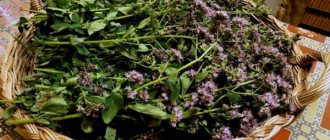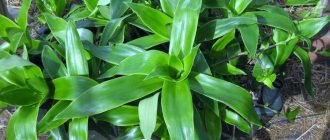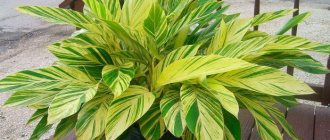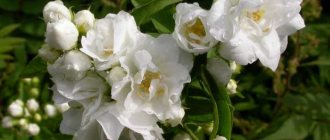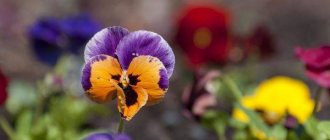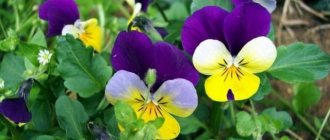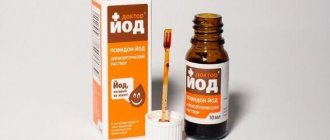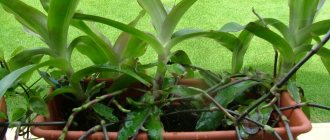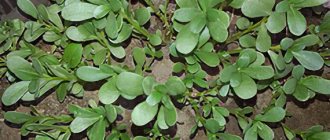Herbal treatment has been around for a very long time and has been successfully used for the recovery of a sick person. Our ancestors walked through the forests in search of valuable plants, collected and made various tinctures and hot decoctions from them.
Let's take a closer look at the world of plants and learn more about the Lyubka bifolia plant.
Description of the plant
This is a herbaceous plant, quite common in our area. Its stem is thick and tall, its length can reach from 45 to 50 centimeters.
The plant has extremely strong roots, thanks to which it burrows deep into the ground and is not afraid of the vagaries of the weather.
The leaves are oblong, green, 10-20 centimeters long, depending on the area in which it grows.The main difference between the flower and all others is its strong, specific smell, which can be smelled at a distance of 1-2 meters.
The flower emits a particularly pronounced smell in rainy weather and at night.
It is interesting to know that this plant is also called “Lubka bifolia nocturna” because of its ability to smell strongly at night.
Scope of application
Lyubka is used in interior and landscape design, medicine and cooking.
Floriculture
Lyubka bifolia is widely used in interior landscape design as a highly decorative plant. It is grown in greenhouses and as a garden decoration. Compositions with Lyubka flowers are used when decorating the interior of premises.
Cooking
Nutritious drinks and products are made from dried tubers of Lyubka bifolia, which contain many useful components:
- a drink known among eastern peoples called kokuya consists of tubers pounded into flour and boiled with honey,
- salep insist on wine or broth, using it as a product that supports strength,
- Caucasian peoples use tubers in preparing first courses, making flour and jelly based on them.
Medicine
The plant is not included in the collection of the State Pharmacopoeia of the Russian Federation, therefore it is not used in official medicine. Lyubka bifolia found its main use in folk medicine.
The medicinal raw materials are mainly tubers, which are harvested at the end of the flowering process or at its last stages. The most fleshy and juicy tubers are cleaned, washed and placed in boiling water for 2-3 minutes, dried in a heating cabinet at a temperature of 50°C or in a dark place. Ready-to-use tubers should be hard and horn-shaped, light yellow in color, odorless and bitter.
For gastrointestinal diseases
For stomach diseases and disorders of the intestinal tract, decoctions based on the roots and tubers of Lyubka bifolia (10 g of dry Lyubka per 200 ml of water) are used, including:
- in cases of diarrhea and discharges of various etiologies;
- for intestinal colitis;
- against gastritis and enteritis.
Genitourinary area
Tuberous decoctions are used for inflammatory processes of the genitourinary area, including inflammation of the bladder and gynecological diseases.
Respiratory system
A drink based on the root with honey is recommended for diseases of the respiratory system, including persistent cough.
External use
Crushed tubers infused in milk, mixed with pork fat, are used in traditional medicine as an external remedy against abscesses and ulcers.
Dosage
If the above-mentioned diagnoses and symptoms are present, internal use of decoctions of 1 tbsp is prescribed. l. 3 times a day. For children, mucus is prepared based on the tubers of Lyubka bifolia, prescribing 1 tsp. 2-3 times a day. When making mucilage, the dried tubers are ground to a powder. 2 g of powder is poured into a glass of boiling water, shaken for 10-15 minutes. until a colorless mucus of thick consistency forms.
Spreading
The plant grows mainly in European countries, but there is also a lot of it in our area. Residents of the Caucasus, the Far East and central Russia can see Lyubka on the edges of forests and plantings.
According to rough estimates by botanists, the largest quantities of this flower grow in countries such as:
- Poland
- Lithuania
- Latvia
- Croatia
- Bulgaria
- Estonia
Medicinal properties of night violet
When describing its medicinal properties, Lyubka bifolia is valued for salep, which upon contact with water turns into a slimy jelly-like mass.
It has antiseptic, enveloping properties that enhance the effect of traditional treatment of diseases of the gastrointestinal tract : enterocolitis, colitis, gastritis, duodenal and stomach ulcers.
It is often used for poisoning, since the salep film prevents the absorption of toxic substances by the walls of the gastrointestinal tract.
The mucous mass of Lyubka has a high energy value. To provide a person with energy for a day, 40 g of dissolved salep is enough. It is also used to support the body in the postoperative period, during protracted and debilitating diseases.
Beneficial features
Based on laboratory studies, the biologist was able to find out its composition and beneficial properties. The plant contains:
- Potassium, magnesium, zinc
- Small amount of echinacea
- Vitamin C
- Aldehydes
With the help of Lyuba bifolia, ENT diseases, stool and digestive disorders, extensive furunculosis on the face and body, and severe toothache are effectively treated.
The juice of the flower is a strong anti-inflammatory agent that completely removes the source of inflammation within a few hours.
In pharmacology, tinctures are made from the juice and added to wound healing ointments. For a detailed study, we advise you to view the photo of Lyubka bifolia.Chemical composition
The medicinal benefits of two-leaf lyubka are due to its chemical composition. The tubers of the plant contain:
- potassium oxalate;
- starch and sugars;
- a large amount of mucus - up to 50%;
- essential oils;
- bitterness;
- amino acids;
- mineral salts.
Due to the listed valuable substances, the plant has good anti-inflammatory and cleansing qualities.
We recommend reading: What are the benefits of peanut butter, composition and calorie content?
Lyubka red
Lyubka bifolia red is a variety of Lyubka bifolia. It grows in forests with a predominantly cold climate.
Its tubers are very valuable in the treatment of acute respiratory viral infections. They strengthen the immune system and prevent viruses from entering the human body.
The plant has many names in scientific nomenclature: cuckoo, night violet, wild balsam and others. Previously, it could be found quite often outside the city, and sometimes in the city itself.
- White sandman - medicinal properties, uses and recipes from traditional medicine (video + 90 photos)
Dubrovnik - beneficial properties of the plant and tips on collecting and choosing herbs (95 photos and videos)
Smoker officinalis - recipes, use in folk medicine, description of the properties and medicinal qualities of the plant (110 photos)
But the unfavorable climatic situation took its toll. Now you can see the plant only in the central part of Russia, in the forests.
Lyubka bifolia red has recently been listed in the Red Book and is protected by the current law of Russia.
The closest relative of the flower is the violet lyubka bifolia; their only difference is the size and the cold climate that the plant loves.
Botanical characteristics
Belongs to the tuberous ornamental wild plants of the Lyubka genus. It is also grown as a garden crop. Lyubka bifolia has several synonymous names:
- wild balm,
- night violet,
- love root,
- cuckoo tears.
The scientific name Platanthera consists of 2 Greek words, translated as “wide pollen sac”, which is associated with the appearance of the plant. The anther of Lyubka bifolia looks like a pollen bag.
Lyubka, like a flower, received its popular name because of its magical properties: according to legend, its tubers were used as a love potion and love potion.
According to the description, the plant grows in height up to 0.2-0.5 m, in rare cases - up to 0.6 m, and has 2 connected pear-shaped root tubers. The stem is thickened towards the root end. Pairs of basal leaves are located opposite each other, light green, with their inherent gloss. The length of the leaf blade is 8-22 cm, width is 3-6 cm. The stem leaves are small, sessile.
The length of the inflorescences is 0.2 m, they are formed in the form of a spike of 8-40 white flowers with a slight yellow tint. The plant has a pleasant aroma, the concentration of which increases in the evening and at night or on a cloudy day, hence the name - night violet. The beginning of the flowering stage is 6-7 years. Flowering period is early and mid-summer.
Preparing a healthy decoction
To make a medicinal decoction against insomnia and headaches, you will need 10 tablespoons of crushed Lyubka bifolia and 5-6 glasses of clean water.
Add the powder to water and boil it for 30-35 minutes, then filter the tincture through a sieve and let it stand for 2 days.
Afterwards you will get a wonderful, tonic decoction that will help get rid of nighttime insomnia and headaches.
Reproduction
This plant reproduces exclusively by seeds. One fruit contains more than 20 thousand seeds. On average, up to 11 fruits ripen on one plant. Seeds germinate only in the presence of fungi. During the first two to four years, the seedling leads an exclusively underground lifestyle, and only in the third to fifth year does the first leaf appear on the surface of the earth. The white night violet blooms approximately 11 years after germination; under favorable conditions, this can occur in the sixth year. This plant can bloom for five to six years without a break, but after particularly abundant flowering there may be a short break. On average, a plant lives 20-27 years, and under favorable conditions it can live longer. Flower buds are formed two years before flowering. Pollination is usually carried out by nocturnal moths (hawk moths and cutworms), after which the perianth soon fades. Seeds ripen one and a half to two months after pollination. Due to the fact that the seeds are very small and light, distribution occurs even with slight movement of air masses. Lyubka bifolia is a wonderful ornamental plant with a strong aroma. It is in great demand among amateur flower growers. However, breeding it is very difficult. Formally, the night violet is a protected plant, but in reality it is almost impossible to organize this. Lyubka flowers are collected en masse to create bouquets, and this leads to a reduction in its range.
Where can I buy?
If you are interested in where to buy Lyubka bifolia, then the best way to do this is via the Internet.
Common goldenrod - healing properties, medicinal qualities, indications and contraindications for the use of goldenrod (120 photos)- Jaundice - description of the plant, medicinal properties and features of use in folk medicine (80 photos)
Field thistle - medicinal properties, recipes, uses and contraindications of thistle (video + photo)
By typing the corresponding query in the search, you will get many sites where people sell the collected plant at an adequate price. You can place an order and later receive the goods at your post office.
Flower care
One cannot call Lyubka bifolia whimsical. However, without paying any attention to this plant, it is difficult to achieve high decorative value. In addition, in cultivation, night violet grows quite slowly, which is the biggest problem.
Lighting
Night violet feels best in shaded areas protected from the scorching sun, so it can even grow under trees.
Temperature
It tolerates extreme heat and frost very well. Does not require additional shelter for the winter.
Humidity
Prefers moderate to medium humidity.
Watering
Additional artificial watering is carried out when the summer is too hot.
Priming
It grows well in both poor and rich fertile soils, but you should remember some features. Usually the crop is grown from seeds, but if you manage to buy a specimen of Lyubka bifolia at a nursery, the flower should be planted with a handful of soil where it grew previously.
This is due to the presence of special microorganisms in it, formed as a result of the growth and renewal of crop tubers. Otherwise, the plant simply will not take root in the new place.
Circumcision
Not required.
Top dressing
May not be carried out on rich and fertile soils. In other cases, one or two feedings are done per season. It is best to use ready-made complexes intended for orchids.
Transfer
A slow growing plant should not be disturbed. The only transplant involves transferring Lyuba bifolia from the nursery to the garden.
Reproduction
The most accessible way to propagate the currently rare and legally protected night violet is by seed. Transfer from wild or cultivated permanent growth environments is not always successful. Therefore, it is better to sow seeds. It is recommended to purchase planting material from trusted stores or from those who grow these flowers and collect seeds.
Sowing of the crop is carried out in early spring. The first week of May is best. Keeping a step of 15 cm, make grooves. They should be small, that is, shallow. They lay the seeds.
In order for the plant to take root successfully, it is necessary to constantly monitor the condition of the soil. It should remain slightly moist all the time and not dry out. The first leaves may appear in the fourth or fifth year.
Photo of Lyubka bifolia
Read here! Cocklebur - medicinal properties, indications and contraindications for use. 135 photos of the plant and video of its use in folk medicine
Please repost
0
Pharmacology
A number of medicinal properties of night violet lyubka:
- enveloping,
- antitoxic,
- tonic,
- anti-inflammatory,
- antiseptic,
- diuretics.
Thanks to the mucus contained in the chemical composition, the plant helps lower blood pressure, can protect the mucous membranes of the stomach and intestines from the irritating effects of substances entering them, and becomes an obstacle to the absorption of toxins. Tubers of Lyubka bifolia (salepa) are known in alternative medicine as a means of increasing sexual activity.
Comments
Hello, Sergey! This year I also saw several species of Penza orchids - in the Kameshkir and Sosnovoborsky districts. A question arose: in your photos is it definitely a two-leaved lyubka, and not a green-flowered one? Everywhere they write that the main difference is the location of the pollinia with pollen: in the bifolia they are close and parallel, in the greenflower they diverge downward. Due to the fact that they are pollinated by various insects.
Hello Tatiana! You made me worry! It’s useful to figure out once again who we have shown here. Let's go in order. Backstory: I came across exactly one Lyubka in the Arbekov forest. Therefore, when I saw her, I shook with joy. However, the conditions for filming were unsuitable, and I couldn’t raise my hand to pull out a plant for filming in another place.
Additional pictures were taken a couple of years later, by which time there were 4 plants within a radius of 5-10 meters. Now I do not rule out that these were different species, although then everything seemed simple. When identifying the plant, I had difficulty specifically with the pollinia; unfortunately, there was only one plant and there was nothing to compare it with. As I determined: according to Gubanov, the first defining feature is the shape of the spur.
In Lyubka bifolia, the spur smoothly tapers to a point; in Lyubka green-flowered, the club-shaped thickening of the spur is clearly noticeable. I checked this sign in photographs of the Plantarium: everything is very clearly visible. That’s actually why I had no doubts. I looked at Penzoved, looked at the triple photo, apparently you meant it. There is an article on Wikipedia about green-flowered lyubka, there is the same photo, but...
In the same article a little higher it is written: “It differs from the closely related Lyuba bifolia in having less fragrant greenish-white flowers and a thicker spur, club-shaped, thickened at the end.” It turns out that the location of the pollinia is a secondary matter? I can’t comment on anything here, because... not an expert in this matter. If I had come across two types at the same time, I would have figured it out)). Anyway, thanks
for the question, next summer I will thoroughly understand this matter, re-photograph the pollinia, spurs and smell the night smells. It is possible that the article will have to be redone, and it would be even better to find two types of lyubka at once.
I have a photo of Lyubka, but I didn’t know there were two of them. Can I send it to you and you tell me your opinion?
The question disappeared - I didn’t read that the green-flowered lyubka has no smell. Ours smells simply intoxicating, reminiscent of a mixture of lily of the valley, jasmine and ylang-ylang.
